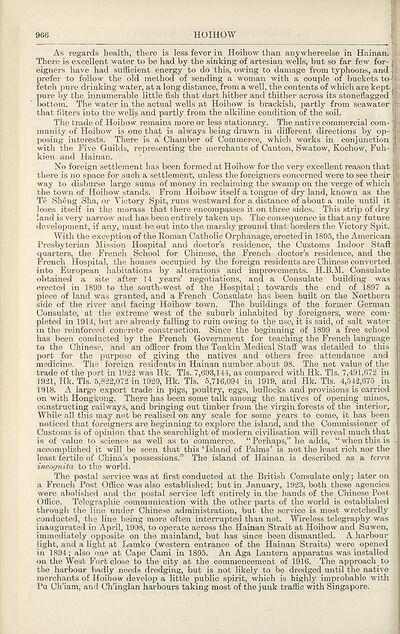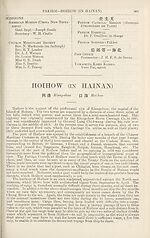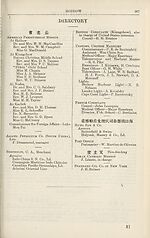1924
(1044) Page 966
Download files
Complete book:
Individual page:
Thumbnail gallery: Grid view | List view

hoihow
966
As regards health, there is less fever in Hoihow than anywhereelse in Hainan* j iji
There is excellent water to be had by the sinking of artesian wells, but so far few for- J -
eigners have had sufficient energy to do this, owing to damage from typhoons, and | a
prefer to follow the old method of sending a woman with a couple of buckets to ■’ *
fetch pure drinking water, at a long distance, from a well, the contents of which are kept
pure by the innumerable little fish that dart hither and thither across its stoneflagged M
bottom. The water in the actual wells at Hoihow is brackish, partly from seawater ]|p:
that filters into the wells and partly from the alkiline condition of the soil.
The trade of Hoihow remains more or less stationary. The native commercial com- fw
munity of Hoihow is one that is always being drawn in different directions by op- |h
posing interests. There is a’ Chamber of Commerce, which works in conjunction jin
with the Five Guilds, representing the merchants of Canton, Swatow, Kochow, Fuh-1-]
kien and Hainan.
No foreign settlement has been formed at Hoihow for the very excellent reason that i
there is no space for such a settlement, unless the foreigners concerned were to see their j
way to disburse large sums of money in reclaiming the swamp on the verge of which !
the town of Hoihow stands. From Hoihow itself a tongue of dry land, known as the j
Te Sheng 8ha, or Victory Spit, runs westward for a distance of about a mile until it j
loses itself in the morass that there encompasses it on three sides. This strip of dry j
land is very narrow and has been entirely taken up. The consequence is that any future j
development, if any, must be out into the marshy ground that borders the Victory Spit. ;
With the exception of the Roman Catholic Orphanage, erected in 1895, the American
Presbyterian Mission Hospital and doctor’s residence, the Customs Indoor Staffs
quarters, the French School for Chinese, the French doctor’s residence, and the
French Hospital, the houses occupied by the foreign residents are Chinese converted
into European habitations by alterations and improvements. H.B.M. Consulate
obtained a site after 14 years’ negotiations, and a Consulate building was
erected in 1899 to the south-west of the Hospital; towards the end of 1897 a ||
piece of land was granted, and a French Consulate has been built on the Northern ;
side of the river and facing Hoihow town. The buildings of the former German i
Consulate, at the extreme west of the suburb inhabited by foreigners, were com- j
pleted in 1914, but are already falling to ruin owing to the use, it is said, of salt water
in the reinforced concrete construction. Since the beginning of 1899 a free school j
has been conducted by the French Government for teaching the French language- t
to the Chinese, and an officer from the Tonkin Medical Staff was detailed to this ;
port for the purpose of giving the natives and others free attendance and ,
medicine. The foreign residents in Hainan number, about 98. The net value of the j
trade of the port in 1922 was Hk. Tls. 7,693,144, as compared with Hk. Tls. 7,491,672 in
1921, Hk. Tls. 5,822,072 in 1920, Hk. Tls. 5,716,094 in 1919, and Hk. Tls. 4,542,675 in
1918. A large export trade in pigs, poultry, eggs, bullocks and provisions is carried |
on with Hongkong. There has been some talk among the natives of opening mines, j
constructing railways, and bringing out timber from the virgin forests of the interior.
While all this may not be realised on any scale for some years to come, it has been |
noticed that foreigners are beginning to explore the island, and the Commissioner of >
Customs is of opinion that the searchlight of modern civilisation will reveal much that
is of value to science as well as to commerce. “Perhaps,” he adds, “whenthis is [
accomplished it will be seen that this ‘Island of Palms’ is not the least rich nor the j
least fertile of China’s possessions.” The island of Hainan is described as a terras
incognita to the world.
The postal service was at first conducted at the British Consulate only; later on
a French Post Office was also established; but in January, 1923, both these agencies- |
were abolished and the postal service left entirely in the hands of the Chinese Post j
Office. Telegraphic communication with the other parts of the world is established j
through the line under Chinese administration, but the service is most wretchedly |
conducted, the line being more often interrupted than not. Wireless telegraphy was j
inaugurated in April, 1908, to operate across the Hainan Strait at Hoihow and Suwen, j
immediately opposite on the mainland, but has since been dismantled. A harbour ;
light, and a light at Lamko (western entrance of the Hainan Straits) were opened j
in 1894; also one at Cape Cami in 1895. An Aga Lantern apparatus was installed
on the West Fort close to the city at the commencement of 1916. The approach to
the harbour badly needs dredging, but is not likely to be dredged until the native ,
merchants of Hoihow develop a little public spirit, which is highly improbable with i
Pu Ch’iam, and Ch’inglan harbours taking most of the junk traffic with Singapore.
966
As regards health, there is less fever in Hoihow than anywhereelse in Hainan* j iji
There is excellent water to be had by the sinking of artesian wells, but so far few for- J -
eigners have had sufficient energy to do this, owing to damage from typhoons, and | a
prefer to follow the old method of sending a woman with a couple of buckets to ■’ *
fetch pure drinking water, at a long distance, from a well, the contents of which are kept
pure by the innumerable little fish that dart hither and thither across its stoneflagged M
bottom. The water in the actual wells at Hoihow is brackish, partly from seawater ]|p:
that filters into the wells and partly from the alkiline condition of the soil.
The trade of Hoihow remains more or less stationary. The native commercial com- fw
munity of Hoihow is one that is always being drawn in different directions by op- |h
posing interests. There is a’ Chamber of Commerce, which works in conjunction jin
with the Five Guilds, representing the merchants of Canton, Swatow, Kochow, Fuh-1-]
kien and Hainan.
No foreign settlement has been formed at Hoihow for the very excellent reason that i
there is no space for such a settlement, unless the foreigners concerned were to see their j
way to disburse large sums of money in reclaiming the swamp on the verge of which !
the town of Hoihow stands. From Hoihow itself a tongue of dry land, known as the j
Te Sheng 8ha, or Victory Spit, runs westward for a distance of about a mile until it j
loses itself in the morass that there encompasses it on three sides. This strip of dry j
land is very narrow and has been entirely taken up. The consequence is that any future j
development, if any, must be out into the marshy ground that borders the Victory Spit. ;
With the exception of the Roman Catholic Orphanage, erected in 1895, the American
Presbyterian Mission Hospital and doctor’s residence, the Customs Indoor Staffs
quarters, the French School for Chinese, the French doctor’s residence, and the
French Hospital, the houses occupied by the foreign residents are Chinese converted
into European habitations by alterations and improvements. H.B.M. Consulate
obtained a site after 14 years’ negotiations, and a Consulate building was
erected in 1899 to the south-west of the Hospital; towards the end of 1897 a ||
piece of land was granted, and a French Consulate has been built on the Northern ;
side of the river and facing Hoihow town. The buildings of the former German i
Consulate, at the extreme west of the suburb inhabited by foreigners, were com- j
pleted in 1914, but are already falling to ruin owing to the use, it is said, of salt water
in the reinforced concrete construction. Since the beginning of 1899 a free school j
has been conducted by the French Government for teaching the French language- t
to the Chinese, and an officer from the Tonkin Medical Staff was detailed to this ;
port for the purpose of giving the natives and others free attendance and ,
medicine. The foreign residents in Hainan number, about 98. The net value of the j
trade of the port in 1922 was Hk. Tls. 7,693,144, as compared with Hk. Tls. 7,491,672 in
1921, Hk. Tls. 5,822,072 in 1920, Hk. Tls. 5,716,094 in 1919, and Hk. Tls. 4,542,675 in
1918. A large export trade in pigs, poultry, eggs, bullocks and provisions is carried |
on with Hongkong. There has been some talk among the natives of opening mines, j
constructing railways, and bringing out timber from the virgin forests of the interior.
While all this may not be realised on any scale for some years to come, it has been |
noticed that foreigners are beginning to explore the island, and the Commissioner of >
Customs is of opinion that the searchlight of modern civilisation will reveal much that
is of value to science as well as to commerce. “Perhaps,” he adds, “whenthis is [
accomplished it will be seen that this ‘Island of Palms’ is not the least rich nor the j
least fertile of China’s possessions.” The island of Hainan is described as a terras
incognita to the world.
The postal service was at first conducted at the British Consulate only; later on
a French Post Office was also established; but in January, 1923, both these agencies- |
were abolished and the postal service left entirely in the hands of the Chinese Post j
Office. Telegraphic communication with the other parts of the world is established j
through the line under Chinese administration, but the service is most wretchedly |
conducted, the line being more often interrupted than not. Wireless telegraphy was j
inaugurated in April, 1908, to operate across the Hainan Strait at Hoihow and Suwen, j
immediately opposite on the mainland, but has since been dismantled. A harbour ;
light, and a light at Lamko (western entrance of the Hainan Straits) were opened j
in 1894; also one at Cape Cami in 1895. An Aga Lantern apparatus was installed
on the West Fort close to the city at the commencement of 1916. The approach to
the harbour badly needs dredging, but is not likely to be dredged until the native ,
merchants of Hoihow develop a little public spirit, which is highly improbable with i
Pu Ch’iam, and Ch’inglan harbours taking most of the junk traffic with Singapore.
Set display mode to:
![]() Universal Viewer |
Universal Viewer | ![]() Mirador |
Large image | Transcription
Mirador |
Large image | Transcription
Images and transcriptions on this page, including medium image downloads, may be used under the Creative Commons Attribution 4.0 International Licence unless otherwise stated. ![]()
| Asian directories and chronicles > 1924 > (1044) Page 966 |
|---|
| Permanent URL | https://digital.nls.uk/196437455 |
|---|
| Attribution and copyright: |
|
|---|---|
| Description | Volumes from the Asian 'Directory and Chronicle' series covering 1917-1941, but missing 1919 and 1923. Compiled annually from a multiplicity of local sources and research. They provide listings of each country's active corporations, foreign residents and government agencies of all nationalities for that year, together with their addresses. Content includes: various treaties; coverage of conflicts; currencies and taxes; consular fees; weights and measures; public holidays; festivals and traditions. A source of information for both Western states and communities of foreigners living in Asia. Published by Hongkong Daily Press. |
|---|---|
| Shelfmark | H3.86.1303 |
| Additional NLS resources: |

